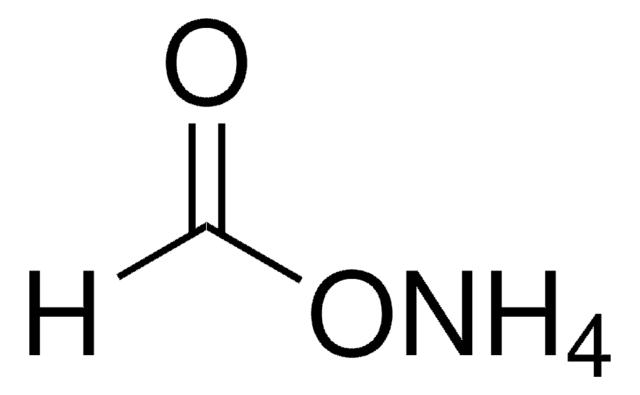27487
Acide citrique
BioUltra, anhydrous, ≥99.5% (T)
About This Item
Produits recommandés
Gamme de produits
BioUltra
Pureté
≥99.5% (T)
Forme
powder or crystals
Limite d'explosivité
8 %, 65 °F
Technique(s)
cell culture | hybridoma: suitable
Impuretés
insoluble matter, passes filter test
Résidus de calcination
≤0.05% (as SO4)
Perte
≤0.5% loss on drying, 110 °C
pH
1.0-2.0 (25 °C, 1 M in H2O)
pKa
(1) 3.13, (2) 4.76, (3) 6.4
Pf
153-159 °C (lit.)
Solubilité
H2O: 1 M at 20 °C, clear, colorless
Traces d'anions
chloride (Cl-): ≤5 mg/kg
oxalate (C2O42-): ≤0.05%
phosphate (PO43-): ≤5 mg/kg
sulfate (SO42-): ≤20 mg/kg
tartrate (C4H4O62-): ≤0.20%
Traces de cations
Al: ≤5 mg/kg
As: ≤0.1 mg/kg
Ba: ≤5 mg/kg
Bi: ≤5 mg/kg
Ca: ≤10 mg/kg
Cd: ≤5 mg/kg
Co: ≤5 mg/kg
Cr: ≤5 mg/kg
Cu: ≤5 mg/kg
Fe: ≤5 mg/kg
K: ≤50 mg/kg
Li: ≤5 mg/kg
Mg: ≤5 mg/kg
Mn: ≤5 mg/kg
Mo: ≤5 mg/kg
Na: ≤50 mg/kg
Ni: ≤5 mg/kg
Pb: ≤5 mg/kg
Sr: ≤5 mg/kg
Zn: ≤5 mg/kg
λmax
260 nm (Amax: ≤0.20)
280 nm (Amax: ≤0.10)
Chaîne SMILES
OC(=O)CC(O)(CC(O)=O)C(O)=O
λ
1 M in H2O
Absorption UV
λ: 260 nm Amax: 0.20
λ: 280 nm Amax: 0.10
InChI
1S/C6H8O7/c7-3(8)1-6(13,5(11)12)2-4(9)10/h13H,1-2H2,(H,7,8)(H,9,10)(H,11,12)
Clé InChI
KRKNYBCHXYNGOX-UHFFFAOYSA-N
Informations sur le gène
human ... SRC(6714)
Vous recherchez des produits similaires ? Visite Guide de comparaison des produits
Description générale
Application
- Enhancing soil microbiomes: Citric acid has been applied to modify soil bacterial communities in saline mudflats, demonstrating its utility in environmental biotechnology for sustainable ecosystem management (Liu et al., 2024).
- Biodegradable packaging in food industry: In food chemistry, citric acid is used in conjunction with polyvinyl alcohol for developing antimicrobial packaging, highlighting its potential in food safety and preservation (Xu et al., 2024).
- Nanomaterial synthesis for engineering applications: Citric acid serves as a key component in the eco-friendly synthesis of hybrid nanomaterials for supercapacitors, underpinning its role in advancing materials science and engineering (Teixeira et al., 2024).
- Environmental science and pollution control: Research utilizes citric acid to study the co-transport of pharmaceuticals and nanoparticles in environmental systems, aiding in the understanding of contaminant dynamics and mitigation strategies (Cui et al., 2024).
- Food science and technology: Citric acid is employed in the formulation of vegan gummies, indicating its versatility in food product development and its impact on textural properties (Rawat et al., 2024).
Mention d'avertissement
Warning
Mentions de danger
Conseils de prudence
Classification des risques
Eye Irrit. 2 - STOT SE 3
Organes cibles
Respiratory system
Code de la classe de stockage
11 - Combustible Solids
Classe de danger pour l'eau (WGK)
WGK 1
Point d'éclair (°F)
Not applicable
Point d'éclair (°C)
Not applicable
Équipement de protection individuelle
dust mask type N95 (US), Eyeshields, Gloves
Certificats d'analyse (COA)
Recherchez un Certificats d'analyse (COA) en saisissant le numéro de lot du produit. Les numéros de lot figurent sur l'étiquette du produit après les mots "Lot" ou "Batch".
Déjà en possession de ce produit ?
Retrouvez la documentation relative aux produits que vous avez récemment achetés dans la Bibliothèque de documents.
Les clients ont également consulté
Notre équipe de scientifiques dispose d'une expérience dans tous les secteurs de la recherche, notamment en sciences de la vie, science des matériaux, synthèse chimique, chromatographie, analyse et dans de nombreux autres domaines..
Contacter notre Service technique




